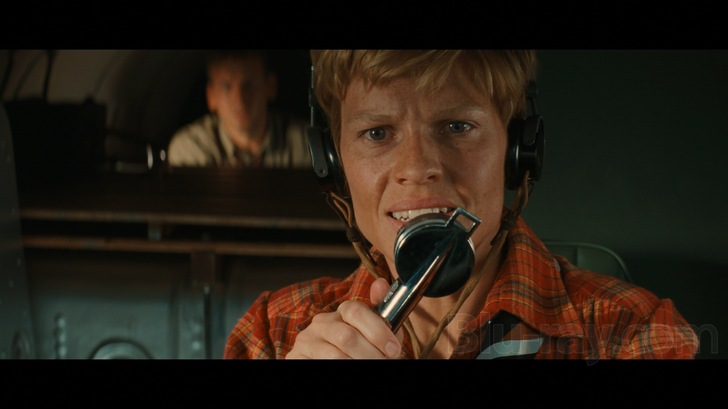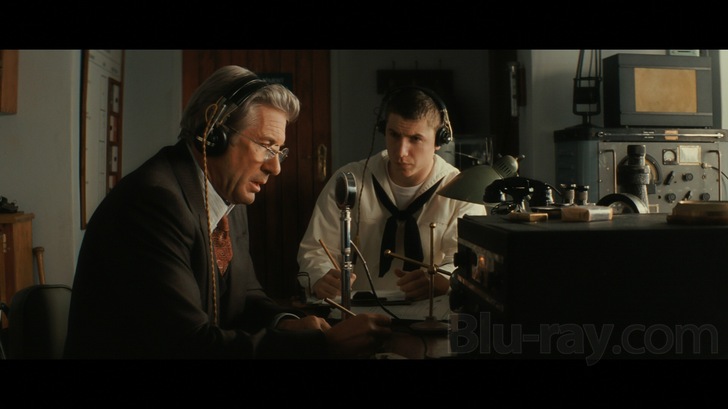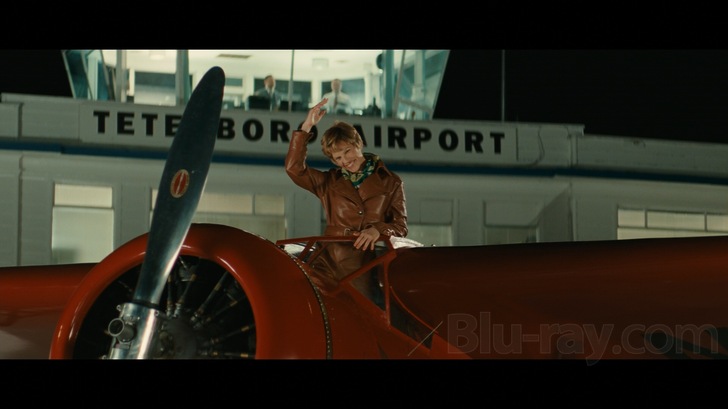Amelia Blu-ray Movie
HomeAmelia Blu-ray Movie 
Blu-ray + Digital Copy20th Century Fox | 2009 | 111 min | Rated PG | Feb 02, 2010

Movie rating
6 | / 10 |
Blu-ray rating
| Users | 3.7 | |
| Reviewer | 3.0 | |
| Overall | 3.6 |
Overview
Amelia (2009)
After becoming the first woman to fly across the Atlantic, Amelia was thrust into a new role as America's sweetheart - the legendary "goddess of light," known for her bold, larger-than-life charisma. Yet, even with her global fame solidified, her belief in flirting with danger and standing up as her own, outspoken woman never changed. She was an inspiration to people everywhere, from First Lady Eleanor Roosevelt to the men closest to her heart: her husband, promoter and publishing magnate George P. Putnam, and her long time friend and lover, pilot Gene Vidal. In the summer of 1937, Amelia set off on her most daunting mission yet: a solo flight around the world that she and George both anxiously foresaw as destined, whatever the outcome, to become one of the most talked-about journeys in history.
Starring: Hilary Swank, Richard Gere, Ewan McGregor, Christopher Eccleston, Joe Anderson (VI)Director: Mira Nair
| Romance | 100% |
| Drama | 93% |
| History | 41% |
| Biography | 37% |
| Period | 33% |
| Adventure | Insignificant |
Specifications
Video
Video codec: MPEG-4 AVC
Video resolution: 1080p
Aspect ratio: 2.35:1
Original aspect ratio: 2.39:1
Audio
English: DTS-HD Master Audio 5.1 (48kHz, 24-bit)
Subtitles
English SDH, French, Spanish
Discs
50GB Blu-ray Disc
Two-disc set (1 BD, 1 DVD)
Digital copy (on disc)
Playback
Region free
Review
Rating summary
| Movie | 3.0 | |
| Video | 4.5 | |
| Audio | 4.0 | |
| Extras | 2.5 | |
| Overall | 3.0 |
Amelia Blu-ray Movie Review
Or, why did director Mira Nair's bio-pic vanish without a trace last October?
Reviewed by Casey Broadwater February 3, 2010We’ve probably all heard a variation of the story—the guy who gets upset when a friend tells him that the ship sinks at the end of James Cameron’s Titanic. Well, spoiler alert, Amelia ends with the famed aviatrix’ Lockheed Electra disappearing somewhere over the Pacific Ocean. We don’t even see it crash. There’s a flash of white, a shot of the endless seascape, a cut to her mourning widower looking out toward the horizon. The film doesn’t indulge any of the juicy speculation that’s been ongoing since she vanished into the blue in 1937. Was Amelia secretly spying on the Japanese for the U.S. government? Did she somehow survive for several months on a remote island populated only by enormous crabs capable of crushing a human skull with their pincers? Might she and her navigator Fred Noonan be the skeletons that were found in the cave during season one of TV’s Lost? All three possibilities are beyond the safe, tepid, historically accurate scope of director Mira Nair’s ultra-dry Amelia, which sticks so staunchly to the grounded facts that the overloaded film never takes flight while wobbling down the runway of its narrative.

The fateful final moments...
Forget the apocryphal theories and post-crash conjectures, though, and think for a minute about the life of high-skies adventure that Amelia Earhart must’ve led. Imagine the thrill of flight, the dangers and risks, and the inherent drama of being a successful female in a male-dominated field. How is it, then, that a film about one of the most iconic women of the 20th century—a proto- feminist and skillful pilot who pushed the bounds of both aviation and gender roles—can be so interminably dull? Is it because her story is so familiar by now that it fails to register as dramatic? I don’t think that’s it. Aside from her solo crossing of the Atlantic and the unsolved mystery of her disappearance, the minutiae of her life are lost on all but the most historically minded aviation enthusiasts. Amelia fills in the blanks, then, but it’s a bit like playing a game of MadLibs with a no-fun literalist. The script by Ronald Bass and Anna Hamilton Phelan—based on two Amelia Earhart biographies—takes us dutifully through all the key moments. Galloping on horseback alongside a taxiing barnstormer, we see a young Amelia (played in adulthood by the horsy Hilary Swank) long for the three-dimensional freedom of flight. We meet PR man George Putnam (Richard Gere), who thinks there just might be a way to make a buck with a female flier who bears a striking resemblance to Charles Lindbergh. Later, he marries her, but the fiercely independent Amelia bucks under authority like a whinnying pony.
While Amelia casts Lady Lindy as the free spirit that she was—founding aviation leagues for women, hopscotching the globe, and forever flashing that awkward, toothy grin—the film tiptoes around controversy, so as not to sully Earhart’s American Hero image. Her hush-hush affair with Ewan McGregor as Gene Vidal—father of future novelist Gore, a child with whom Amelia shares a few overly tender moments—is reduced to a passionless kiss in an elevator, and assumptions of bisexuality are carefully demurred. Not that the film needs scandal, it’s just that there’s very little in the way of dramatic tension or thematic unity. Director Mira Nair can’t seem to find the film’s emotional through-line, the central thread that holds it all together. The film sprawls, then, but with no surprises, no passion, and no foreseeable endpoint except the inevitable splashdown in the Pacific. And even this climactic sequence, which should be filled with white-knuckle moments, is drawn out and oddly emotionless. Stoic in the face of death, sure I get that, but where the film really fails throughout is in its inability to capture the sheer joy of flying, the surge of adrenaline, and the unfettered freedom that Amelia craved. She definitely tells us about it—“I fly for the fun of it,” she says, and later, that she wants to be a “vagabond of the air”—but we never see it. As a professor of film studies, you’d think Nair would know that, cinematically, it’s almost always better to show than to tell.
That’s not to say that Amelia lacks visual splendor. This is a handsome, stately production that looks every penny of its $40 million budget. Stuart Dryburgh’s sumptuous cinematography drips with color and detail, the production design is elegant, and the costuming will have you pining for the days when everyone looked effortlessly dapper. But while all the period piece accoutrements are carefully in place—the Art Deco architecture and flapper fashions, the warbling jazz melodies and ticker tape parades—Amelia feels like a historical home that’s been meticulously restored by some preservation society. It’s roped off and far too clean. There’s simply no life in it. The meandering script is partly to blame, but the actors might just as well be animatronic wax figures, here to spout expository dialogue for your education. Richard Gere is dreary and tame as George Putnam, the famed granddaddy of public relations, and his 1930s radio announcer accent is slightly ridiculous. Ewan McGregor is appropriately debonair, but he’s essentially stuck in the lifestyle of the rich and boring. And while Christopher Eccleston does get a bit more complexity to work with as Amelia’s functionally drunk navigator Fred Noonan, their relationship isn’t developed enough to make a difference.
Which brings us to Hilary Swank, who bares an uncanny resemblance to Amelia Earhart, especially with the aid of a shaggy haircut and a buck-toothed dental prosthetic. Swank sinks into the character, latching on to Earhart’s chipper bashfulness, a modesty that belied her independence and girl-power spunk. There are brief moments when the transformation is complete and you wholly believe that Swank is Earhart, cocking her head, flashing those pearly whites, and waving a confident farewell. But ultimately, there’s a nagging awareness that Amelia is nothing more than an Oscar vehicle for Swank, a vehicle whose disappearance from theaters last October is infinitely less mysterious than Lady Lindy’s almost mythic vanishing act some 73 years ago.
Amelia Blu-ray Movie, Video Quality 

While the film comes as a dull disappointment, Amelia's 1080p/AVC-encoded transfer is anything but, taking flight with an image that's remarkably detailed and full of color. If the film has one saving grace, it's Stuart Dryburgh's cinematography, which paints a warm, vivid picture using a unified palette featuring prominent reds, especially of the primary, fire-engine, freshly picked cherry variety. Whether we're on the dusty plains of Gambia or in the middle of a misty Nova Scotian morning, color is deeply saturated and the image as a whole is frequently striking, with superlative depth and presence. Skin tones are entirely natural, black levels are consistently inky, shadow delineation is sublime, and strong but never over-pushed contrast gives the image a substantial dimensionality. And clarity keeps up with color, no problem. You'll count rivets on the side of the Lockheed Electra, note the texture on a leather flight jacket, spot each bit of grime on an engine cowling, and make out each dusty orange strand of Amelia's hair. I did spot some uncharacteristic softness around the edges of the frame during a few shots, and the thankfully infrequently used CGI isn't exactly convincing, but it's fruitless to nitpick about this gorgeous transfer. Grain is exceedingly fine, and there are no overt technical anomalies to spoil the look.
Amelia Blu-ray Movie, Audio Quality 

With all those whooshing, diving, stalling, rumbling, and taxiing planes, you might expect Amelia to have a beefy soundtrack, heavy on directional effects and low-end rumble. And there is a little bit of that, but the film's DTS-HD Master Audio 5.1 surround track is almost as uninvolving as the gripless narrative. Don't get me wrong; nothing sounds bad—there really are no audio slipups to be found here—but this is one of those tracks that doesn't capitalize on the sonic possibilities inherent in the story. Rear channel usage is kept fairly quiet. Propellers buzz, planes zip by from left to right, thunder peels and rain pours, crowds of journalists chatter and set off flashbulbs, but it's all kept to a safe volume so as not to disrupt the period piece's unwavering decorum. Likewise, Gabriel Yared's faux-inspirational score never booms the way it could, though there's plenty of high-end detail to be heard and a robust mid-range. Dialogue is the most important aspect of the mix here, and it's practically flawless. Aside from a few shouted commands that get muffled (realistically) in the roar of the engines, the lines are all easy to understand and carry a convincing acoustic presence. You might call this track perfectly adequate, but never exceptional.
Amelia Blu-ray Movie, Special Features and Extras 

Making Amelia (1080i, 23:06)
A fairly substantial making-of documentary, Making Amelia explores Hilary Swank's
transformation, the personal life of Amelia Earhart, and the challenges of scouting locations
where you can land antique airplanes. Features interviews with Mira Nair, Hilary Swank, Richard
Gere, and several others.
The Power of Amelia Earhart (1080i, 10:45)
Culled from the same interview sessions in the previous documentary, the focus here is initially
on Amelia's cultural legacy, but it veers incongruously into the film's production and costume
design.
The Plane Behind the Legend (1080i, 4:33)
Mira Nair discusses how she really didn't want the film to turn into a "computer graphics fest," so
it was important to find a fully functioning Lockheed Electra. Granted, the one in the film is from
1941, so it's slightly different from the one Amelia actually flew, but unless you're an aviation nut
you probably won't be able to tell the difference.
Re-Constructing the Planes of Amelia (1080i, 6:37)
Visual Consultant Paul Austerberry leads us through the warehouse where the preproduction
crew built full-size mockups of four planes featured in the film.
Movietone News (SD, 6:41 total)
This is the highlight of the bonus features, in my opinion, as we get seven original Fox Movietone
news reels that cover several of Amelia Earhart's flights.
Deleted Scenes (1080p, 13:53 total)
Includes ten deleted scenes, most of which explain minor plot points and fill in the gaps.
Amelia Blu-ray Movie, Overall Score and Recommendation 

As a long-time aviation geek, I thought that I might enjoy Amelia on the basis of its subject matter alone. While the sleek aircraft featured in the film are works of art in their own right, the film is a desiccated drama that sucks all the joy out of flying and fails to give us any new insight about the life and times of Lady Lindy. Safe, predictable, and unwilling to take any risks, Amelia's tone flatly contradicts the boundary-breaking life of the actual Amelia. The film was one of my biggest theatrical disappointments of 2009, and the feeling hasn't changed on Blu-ray, despite a sparkling video transfer, a capable audio track, and a host of supplementary features. The material may still interest some, I'd suggest a try-before-you-buy rental.
Similar titles
Similar titles you might also like

The Private Lives of Elizabeth and Essex
Warner Archive Collection
1939

Elizabeth: The Golden Age
2007

The Adventures of Robin Hood
1938

Tulip Fever
2017

The Scarlet Empress
1934

Bird of Paradise
1932

Jefferson in Paris
1995

Becoming Jane
2007

Elizabeth
1998

Cleopatra
1963

Belle
2013

The Danish Girl
2015

The Duchess
2008

Désirée
Limited Edition to 3000 - SOLD OUT
1954

Mutiny on the Bounty
1962

The Railway Man
2013

The Other Boleyn Girl
2008

The Woman Between
1931

The Artist
2011

The Young Victoria
2009
